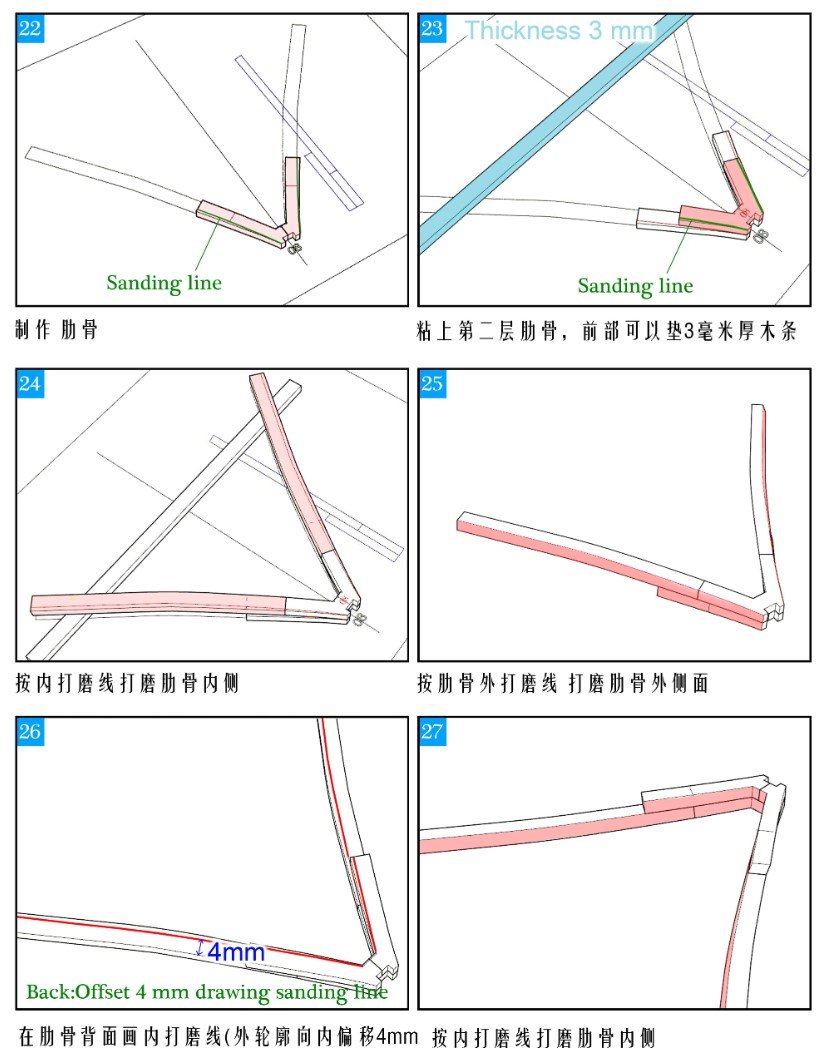-
Posts
3,585 -
Joined
-
Last visited
Content Type
Profiles
Forums
Gallery
Events
Everything posted by yvesvidal
-
After studying the instructions (there are none) and the plans mainly, I decided to steer my attention to the stern. Instead of building Frames #71 to #80, I concentrated on the very last frames indicated by the plan and the Monograph. The reason is the lack of space, if you decide to glue the frames located before #80. The reasoning and the same approach were also used for the bow. There is a rather complex assembly taking place between Frame #84 and Frame #M. The three frames must be part of the same set and must fit perfectly on the stern keel. As usual, the first step is to fit the frame footing on the keel, after using my Dremel to start fairing the frame. Verification that it fits well on the keel. Then the sides are glued in position, in the cradle. The same is done for the following Frame "J". Finally, the intermediate parts are glued (after some fairing) and the two frames are positioned and glued together: It is all extremely delicate and I am not even sure this assembly will look okay with the rest of the hull and frames. The third frames "M" is glued as well without forgetting the intermediate parts and set in position as described above. We end up with something that looks like the picture below: It is all extremely delicate and the two openings for the guns must be carefully carved on each side. The part is now finished and I will post more pictures soon. Yves
-
Make sure that the "bucket" is absolutely waterproof. Resin manages to find the smallest hole or crack by capillarity. It is worse than water. Yves
-
Frames #61 to #70 have been completed. These are a lot more difficult and do require to be taken as a little project, one at a time. Consulting the plan and the Monograph helps tremendously, as well as creating a routine and sticking to it. All frames are made of cherry wood and finely sanded, oiled and waxed. The most delicate was #66, composed of 5 parts and rather difficult to fit it into the cradle: All the new frames are being dry fitted. No glue yet. Just 18 more to go..... Last segment of the keelson is not glued yet. Yves
-
A few updates on this passenger car: I have just completed the ends. I gave up on the couplers provided by OCCRE, as they are not reliable, are not prototypical and makes no sense. Instead that Spanish car will be equipped with American knuckle couplers from Kadee. This way, I will be able to pull this car with an American engine and it will look better overall. I still have to paint the trucks, which is not an easy task as the wheels have to be protected from the spray. We are coming to an end for this kit. Yves
-
A little update, still working on the frames. It seems endless.... Frames #51 to #60 have been built. These frames are still part of what can be considered "easy frames" as they do not require very much of a fairing (inside and outside) and are composed of only three parts. At this point, Frames #1 to #60 have been installed and glued on the keel: I also dry-fitted the keelson. Yves
-
A real beauty, Ras. And what an unusual model on top of that. Yves
- 128 replies
-
- zulu
- sternwheeler
-
(and 1 more)
Tagged with:
-
Frames #2 to #9 have been built. They are by far, the most difficult and delicate to install. There is a lot of sanding that takes place to fair them externally and internally and the insertion on the keel requires a lot of delicate sanding and numerous attempts. The CAF Model kit is very close to the Monograph and did not take the short cuts seen on the ZHL kits, which simply place each frame in a slot. The picture below shows what I mean: The frames are ready to install. Because of the severely restricted space, you need to build one frame at a time and make sure it fits perfectly. No gluing must take place at this stage. Then, when all frames are ready, I find it easier to glue #2 first and go to #9, one at a time. Above, Frames #2 and #3 have been glued. I use CA glue, since it is not practical to use Titebond at this location. Above, three more frames to go..... And it is over for the front: At this stage, a good half of the frames have been installed (#1 to #50). We will encounter some difficult frames again, when moving to the stern. Yves
-
Since there were some interests and concerns about building the frames, here is the step by step approach I am taking. Let's focus on Frame #15, which is one of the delicate and more complicated to build: After removing the five pieces that make #15, the following central parts are glued: The long ribs are then carefully sanded using a Dremel, a semi-round file and some sandpaper: The center piece (there must be a technical term for that...) is not touched yet, besides sanding and opening the slot to make sure it fits on the keel, smoothly but tightly. Fairing of the long ribs must be done on the external side and also on the internal side. Thinking and visualizing how the ribs will fit is paramount. Then glue (Titebond will give you time to adjust the parts in situ) the two long ribs to the center piece and place it in the jig, on the keel: You can see that the fairing done on the outside, allows the frame to fit perfectly in the jig. Small clamps are used to hold the parts during drying. Lots of verification to make sure that everything fits nicely. When dry, remove the frame from the jig: Now is the time to sand and polish the center part. When done, another verification in situ: The frame can now be oiled and waxed, using my favorite Howard mixture: Once all the lints has been removed and when the part is dry, it can be inserted back into the jig, before the final gluing to the keel: Now, redo the same for Frame #14. Yves
-
You really have to sand the ribs as much as possible, before inserting them in the building jig. Multiple reasons for that: Fairing internally and externally must be done ahead of time, because the internal planking will be glued when the hull is inside the jig. For the frames to be extracted from the jig, they must be slightly smaller/less thick and well polished/sanded so that they can slide out without breaking. I noticed that oiling and waxing them before gluing them, helps tremendously. I still suspect that extracting the spine and frames from the jig is going to be nerve wracking. I think I will insert some kind of crowbar from below and push up the keel very gently. Right now, with about 30 frames in, it is still possible to move it a tad. Finally, the hull is not planked on the outside, with the exception of a plank or two. The goal is to show the skeleton of the ship. I need to check with Tom, when is the ideal and safest step to take the hull out of the jig. This is not clear in the instructions. Yves
-
Interesting project. Please, make sure you post figures of your 3D design and perhaps think of how this can be turned into a virtual kit for 3D printing enthusiasts. You have made some very serious 3D models in the past and there may be a few aficionados that would love to build your kits. I know I like these dreadnoughts that you built in the past. Yves
-
I am trying to finish the underside of the coach: Another couple of parts missing from the OCCRE kit: the straight cables/bars, as you can see below. I replaced them with 2 mm brass wire, but that is forcing me to paint them, instead of being able to keep the metal shine. This is the third part missing from this kit, all in the cast metal section..... Not good for Occre. Installing the steps: Alright, we are getting close to the end. I have the trucks and couplers to complete... Yves
-
The tedious and repetitive assembly of the frames has started. I have decided to populate first, the "easy" frames located in the middle of the hull. These do not require any fairing, for the most part and are composed of only three parts. Bow and stern will be kept for the end as they are significantly more advanced and delicate. Frames #30 to #40 are now completed and ....glued to the keel: The next series will be #41 to #50. I have started using a DREMEL equipped with a round abrasive head, after loosing a good chunk of skin on my fingers....due to sand paper abrasion. It really helps. Yves
About us
Modelshipworld - Advancing Ship Modeling through Research
SSL Secured
Your security is important for us so this Website is SSL-Secured
NRG Mailing Address
Nautical Research Guild
237 South Lincoln Street
Westmont IL, 60559-1917
Model Ship World ® and the MSW logo are Registered Trademarks, and belong to the Nautical Research Guild (United States Patent and Trademark Office: No. 6,929,264 & No. 6,929,274, registered Dec. 20, 2022)
Helpful Links
About the NRG
If you enjoy building ship models that are historically accurate as well as beautiful, then The Nautical Research Guild (NRG) is just right for you.
The Guild is a non-profit educational organization whose mission is to “Advance Ship Modeling Through Research”. We provide support to our members in their efforts to raise the quality of their model ships.
The Nautical Research Guild has published our world-renowned quarterly magazine, The Nautical Research Journal, since 1955. The pages of the Journal are full of articles by accomplished ship modelers who show you how they create those exquisite details on their models, and by maritime historians who show you the correct details to build. The Journal is available in both print and digital editions. Go to the NRG web site (www.thenrg.org) to download a complimentary digital copy of the Journal. The NRG also publishes plan sets, books and compilations of back issues of the Journal and the former Ships in Scale and Model Ship Builder magazines.









